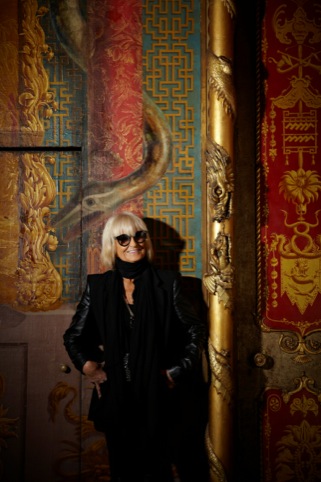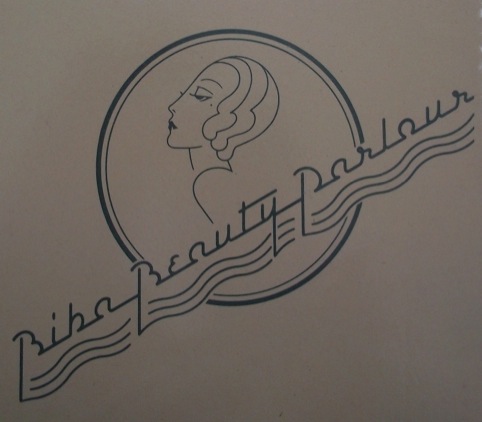Biba founder Barbara Hulanicki chats to Design Week
It’s a rather daunting prospect interviewing Barbara Hulanicki. However, when she opens the door to ‘a friend’s’ gorgeous, eclectic West London house, she’s charming, warm and funny, resplendent in her signature all-black and sunglasses.

Source: Tessa Hallmann © Royal Pavilion and Museums
Barbara Hulanicki, Royal Pavilion 2012
Indeed, it’s almost impossible to believe that this is the woman who transformed the high-street retail experience when she founded the iconic Biba store and label in 1964, with late husband Stephen Fitz-Simon.
With its rebellious attitude, dimly-lit environs and loud rock music, Biba turned high-street shopping into a glamorous escapism. Best of all, it was affordable escapism: a magical boutique aesthetic, yet a democratic one. Whether you were buying tins of dog food, form the belly of an enormous Great Dane; soup from a huge Warhol Campbell’s can or childrenswear from a fairy-tale forest, Biba injected fantasy into the quotidian and bold theatrics into shopping that transformed the way Britain saw the high street.
Ahead of the Biba and Beyond: Barbara Hulanicki exhibition that opens in Brighton in September, we spoke to Hulanicki about finding inspiration in funeral parlours, Biba’s sustained iconic status and the multiple projects she’s still working on into her mid 70s.

Source: Image taken from Welcome to Big Biba: Inside the Most Beautiful Store in the World by Steven Thomas
Big Biba store interior
Design Week: What do you think it is about the Biba brand that’s still capturing people’s imaginations?
Barbara Hulanicki: Isn’t it strange… I guess because it wasn’t corporate, to start with. Everything’s very corporate now. It’s been passed on, too – I’ve always advised designers now to do children’s clothes as you’re got another generation coming up and it gets passed on. I think the mums who had the dresses kept them to show their kids how little and skinny they were! I think that period was very strong and it’s a very emotional period – before that it was on the cups of being Victorian stuffiness and it broke though. It was terribly rebellious and wicked – and it wasn’t really when you look at it now – it was rather sweet. But sometimes I get stopped with people saying ‘We married because we met in Biba’ or ‘we called our child Biba’ and it’s so sweet – it’s really nice.
DW: Tell me more about the stores’ visual aesthetics
BH: I wanted it to be like a sitting room where people hung out. At the time it was very dark because that was rebellion. We always picked really nice old premises that had a lot of energy in it already. My husband then hated shopping so we put seats in for the men and boys so they could sit and watch the girls. It was a little club atmosphere in the day I suppose.

Source: Image taken from Welcome to Big Biba: Inside the Most Beautiful Store in the World by Steven Thomas
Big Biba store interior
DW: Was anyone doing anything similar?
BH: No absolutely not. I always imagined that’s what Paris boutiques were like but they weren’t really. All the furniture came from junk shops – that’s how people furnished their homes because it was cheap. Everything was at a young level.
DW: For the big Biba Biba store [a six-storey department store that opened in 1973 on Kensington High Street] each of the 15 departments had its own logo, and seven new typefaces were designed to have one for each floor. How important was the graphics aspect?
BH: It was tremendously so. Right at the beginning when we started with Biba Postal Boutique [the mail-order business founded by Hulanicki and husband Stephen Fitz-Simon in 1961] people didn’t like it though – the minute we put the logo in the window people didn’t like it so we took it out. With the next shop [in Church Street] we felt it needed an identity of some sort. There was this wonderful funeral parlour across the road in Church Street, which was purple and black and gold and I thought this is just where we want to be – Dracula and all that. A friend of mine Tony Little did the first Aubrey Beardsley-like logo then John McConnell did the next one when we moved and were getting more sophisticated I guess. By the time we got to the big store it was really important to have a different identity on each floor. Funnily enough I was terribly into Disney – the Disney property in LA was just so beautiful and every floor had a different theme and logo and identity and that’s I guess how it happened.

Source: Copyright SteveThomas
Biba Beauty Parlour Logo 1973, designed by Steve Thomas
DW: Do you think it was that fantasy and escapism that people were looking for?
BH: Yes, yes– there was nothing then. People didn’t travel and you were bringing a lot of ideas that that age-group had never seen before.
DW: How did you ensure you maintained a boutique feel over such a huge store, with Big Biba?
BH: It was very easy – every floor had its own little life and different girls. They were always very involved in whatever they were doing – there was dramas and other little things. It wasn’t difficult at all. People were very warm then – it was very democratic.
DW: It seems there was a lot of crossover with that art world – for Big Biba there were Andrew Logan’s sculptures on the roof garden, the Warhol Campbell’s display and obviously really ornate visual merchandising, what inspired you for those elements?
BH: To us if you wanted to buy dog food it was in a dog’s tummy! Everybody was still doing this for the first time. They didn’t want to go into the horrible old corner shop that was really boring – everything was very much inspired by movies and being brought up on a lot of Technicolor film. One didn’t look at it as art – it was just props.

Source: Image taken from Welcome to Big Biba: Inside the Most Beautiful Store in the World by Steven Thomas
Big Biba store Food Hall
DW: Do you think any stores today are trying to create that theatrical aesthetic?
BH: I think a lot are trying with bits of it – the PR is always so fantastic and you get there and say ‘where is it all’. Or they just do one window and by the time you get there it’s gone, over with. I think things are different now – it’s all ‘do it quickly’ while the idea is hot but it’s too much effort, there’s no risk taking. It’s not a risk really its showbiz, isn’t it – or it should be. But maybe I saw too many 1950s films in Technicolor with Esther Williams!
DW: You’ve worked in so many different fields- fashion photography, illustration, retail, product design [Hulanicki has a range of homeware including wallpaper, wall art and paint, and is currently designing cushions for TK Maxx], clothing design, with the on-going George @ Asda collaboration– what area are you enjoying most at the moment?
BH: I love photography but it’s got so technical now. But I guess I’d love to be able to sit down and not get frightened of it all. I had this marvellous old camera that had a minus and a plus – it worked very well. I love working on hotels [Hulanikci designs house and hotel interiors]– it’s wonderful. It takes quite a while, where clothes is very quick. Some of the location are marvellous like Jamaica and the Bahamas – everything slows down so you have to go in the same tempo. Which is non-existent.
Biba and Beyond: Barbara Hulanicki runs from 22 September – 14 April at Brighton Museum & Art Gallery, Royal Pavilion, 4/5 Pavilion Buildings, Brighton and Hove, Brighton, East Sussex BN1
-
Post a comment




